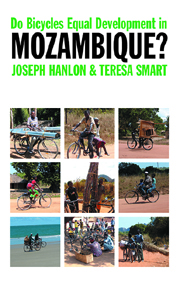Book contents
- Frontmatter
- Contents
- Acknowledgements
- The authors
- Money & measurements
- Abbreviations, acronyms & glossary
- Part I IS THERE DEVELOPMENT IN MOZAMBIQUE?
- 1 Introduction: more bicycles, but …
- 2 A brief history: war, peace & slow recovery
- 3 Can peasants pull Nampula out of poverty?
- 4 The Manica miracle is over
- 5 Cashew: from disaster to export model
- 6 Tobacco: hard choices
- 7 Has poverty decreased?
- 8 Is there development in Mozambique?
- Part II ACTORS & CONTEXT
- Part III ALTERNATIVES & THE DEVELOPMENTAL STATE
- Appendix 1 Aid
- Appendix 2 Investment & other tables
- Bibliography
- Index
5 - Cashew: from disaster to export model
from Part I - IS THERE DEVELOPMENT IN MOZAMBIQUE?
Published online by Cambridge University Press: 05 April 2013
- Frontmatter
- Contents
- Acknowledgements
- The authors
- Money & measurements
- Abbreviations, acronyms & glossary
- Part I IS THERE DEVELOPMENT IN MOZAMBIQUE?
- 1 Introduction: more bicycles, but …
- 2 A brief history: war, peace & slow recovery
- 3 Can peasants pull Nampula out of poverty?
- 4 The Manica miracle is over
- 5 Cashew: from disaster to export model
- 6 Tobacco: hard choices
- 7 Has poverty decreased?
- 8 Is there development in Mozambique?
- Part II ACTORS & CONTEXT
- Part III ALTERNATIVES & THE DEVELOPMENTAL STATE
- Appendix 1 Aid
- Appendix 2 Investment & other tables
- Bibliography
- Index
Summary
Warren, who runs the nut stall in our local street market in London, sells Mozambican cashew nuts. ‘Better quality than the ones from other countries,’ he told us. And therein lies a tale of an industry destroyed and resurrected, with perhaps some lessons as to how Mozambican peasants can survive in a globalised world. Mozambique was the world's largest producer of cashew nuts until 1977, and the nut seems ideal for a poor country since it is grown by millions of peasants on poor land and processing employs thousands of people. In this chapter we look at three overlapping phases of cashew:
1972–98:The industry was declining due to lack of investment even before independence, and was largely killed by the war. Then in the mid-1990s it was resurrected by privatisation, with a peak of production and employment in 1998.
1995–2001. Despite renewed hopes, the industry was killed again by World Bank and IMF zealotry in imposing a free trade policy. Cashew became one of the emblematic examples of harmful policies imposed on poor countries by the BWIs. By 2002 all but four tiny factories had closed.
From 2001. A new government policy rejecting the World Bank line and supporting local industry was adopted in 2001. Combined with support for the entire value chain by INGOs and local institutions, this created an entire new cashew industry. By 2006 there were 18 factories and 6,000 workers, and the sector is continuing to expand rapidly.
- Type
- Chapter
- Information
- Do Bicycles Equal Development in Mozambique? , pp. 36 - 50Publisher: Boydell & BrewerPrint publication year: 2008



